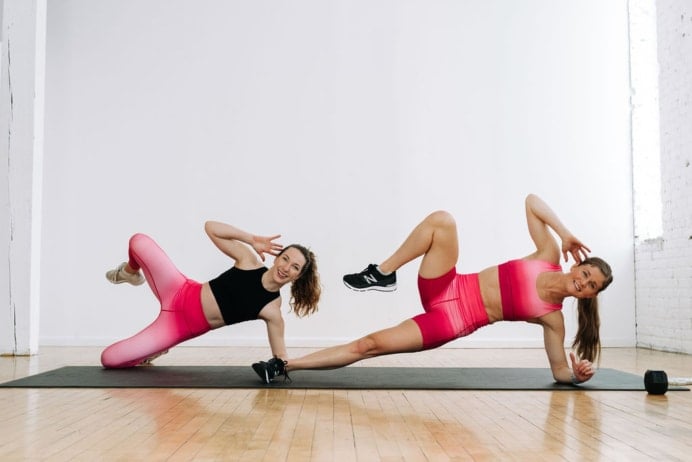
30-Minute Pilates Workout
This 30-minute, no-equipment Pilates workout is ideal for anyone looking to build functional strength, improve posture and increase flexibility from home. Designed to target the core, glutes and stabilizing muscles, these exercises help tone and lengthen while also enhancing balance, mobility and everyday movement. Perfect for all levels, it’s a low-impact but effective way to strengthen and sculpt your whole body.
When I first started Pilates, I thought it was mostly stretching or slow, easy movements. It didn’t take me long to realize it’s more than that. Pilates is a total-body workout that focuses on strength, stability, posture and control. It’s not just about working your abs – it teaches your body how to move better in everyday life. That’s what makes Pilates such a powerful form of functional fitness. By targeting the deep stabilizing muscles around the core, hips and shoulders, Pilates helps improve balance, mobility and joint health. Over time, you’ll notice that things like carrying groceries, sitting at your desk or even running and lifting become easier and more efficient.
Developed by Joseph Pilates, a Pilates workout routine focuses on core strength, posture, mobility and intentional, controlled movements. That makes Pilates great for building strength and supporting weight loss. What I love most is that Pilates goes beyond burning calories. It tones your muscles, strengthens your core and trains your body to move with better alignment. That means less stiffness, fewer aches and better posture. Pilates is also great for both toning and fat loss, since it combines strength work with controlled endurance.
Some people also wonder if Pilates is better than lifting weights in the gym. I wouldn’t say one is better than the other because it truly depends on your goals. Heavy lifting in the gym is great for building muscle mass, but the best Pilates routines strengthen your body in ways the gym often misses. By focusing on flexibility, mobility and stabilization, you’re better equipped to prevent injury.
You also don’t need a Pilates reformer or an expensive studio membership to get these benefits. At-home Pilates workouts are just as effective as in-person classes if you approach them with focus and consistency. All you need is a mat (or just some open floor space). In fact, practicing at home can help you build awareness of your own body, since you’re relying less on cues from an instructor and more on internal connection.
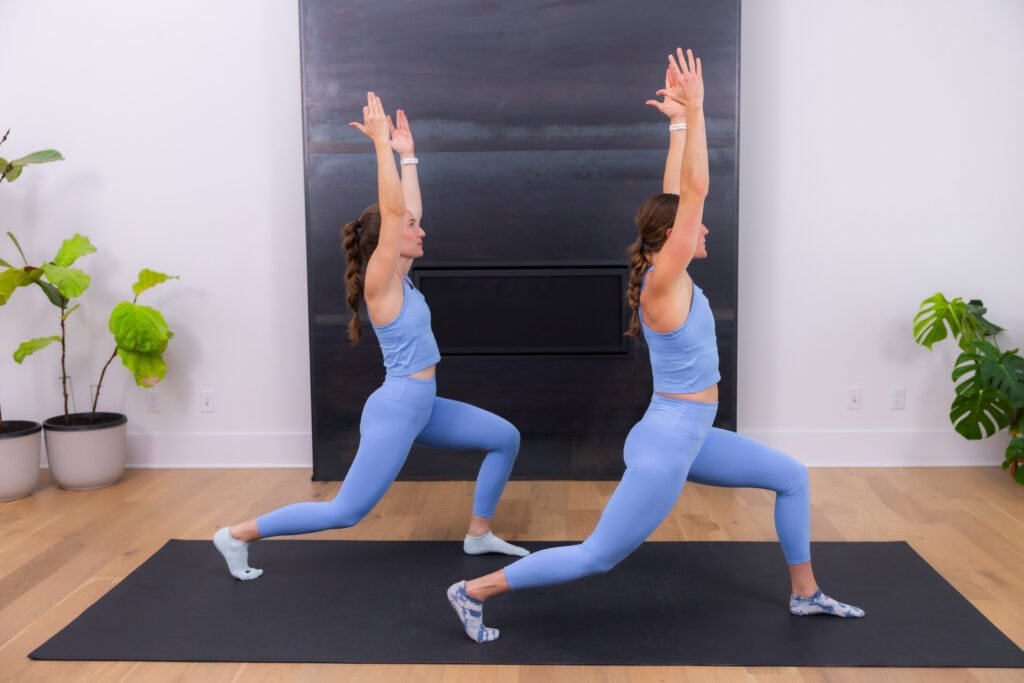
This 30-minute no-equipment power Pilates workout blends traditional mat Pilates exercises with barre-inspired sequences and a touch of cardio. It’s designed to:
- Build deep core strength and stability
- Improve posture and flexibility
- Reduce lower back pain
- Enhance balance and coordination
- Support fat loss and lean muscle tone
- Increase joint mobility and reduce injury risk
- Improve functional strength for everyday movement
By the end of this intermediate Pilates session, you’ll feel stronger and energized.
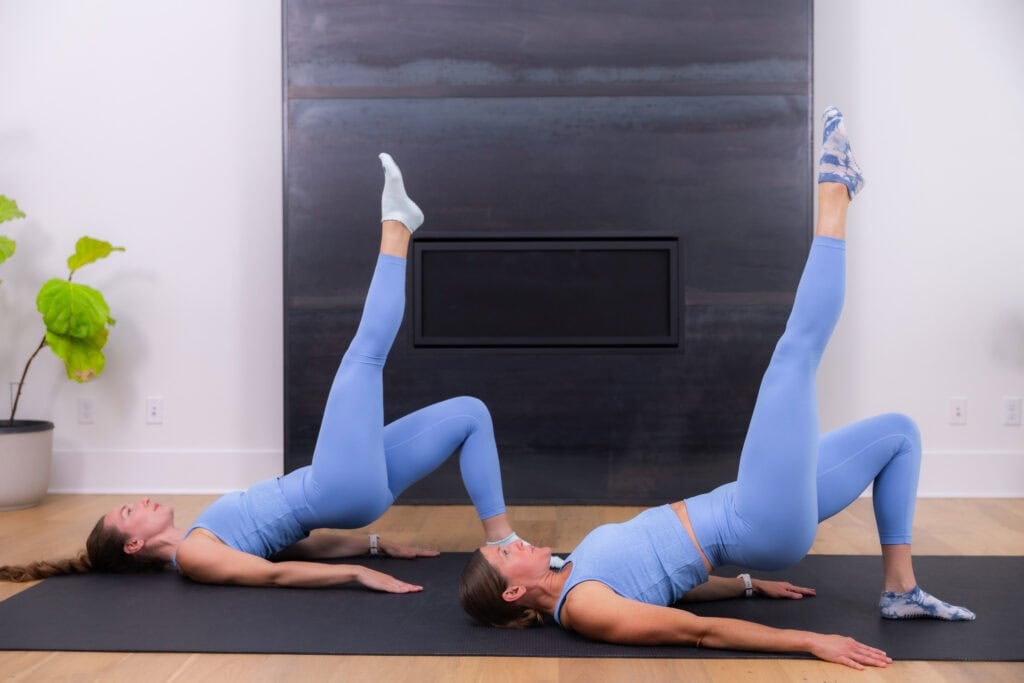
Workout Details
Build lean muscle with this home Pilates workout. I’ll coach you through a brief warm-up, then we’ll jump into this full-body workout video.
I recommend adding Pilates workouts like this one to your weekly workout routine 1-2 times a week. Note that there is a modifier in this workout video, but I’d also recommend this beginner-friendly Pilates routine or this prenatal Pilates routine if you need specific modifications.
Workout Equipment
No equipment needed for this bodyweight-only Pilates workout.
Workout Instructions
Follow along with the guided full video: Full-Body Pilates Workout on my YouTube Channel, led by me — your certified barre/pilates instructor, Lindsey Bomgren.
Your Workout Looks Like This:
- Variety of Pilates Exercises
- Guided Flow (Spending approximately 60-90 seconds on each exercise before moving on to the next. Complete as many reps as you can in the timed interval.)
Workout Outline
1. Seesaw Plank
Targets: Upper abs, lower abs, obliques, shoulders, glutes and thighs.
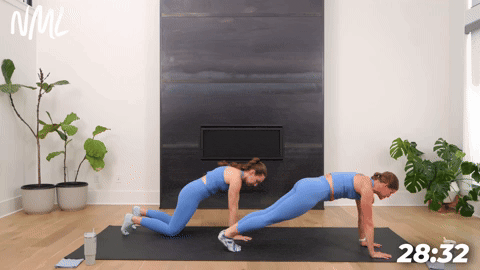
How to Do a Seesaw Plank
- Start in a high plank position with your shoulders stacked over your wrists, with your weight evenly distributed among all 10 fingers. Your body forms a straight line from head to heels. Engage your deep core and pelvic floor by pulling your belly button in towards your spine.
- Rock forward, shifting to press your nose over your fingertips. Focus on keeping your hips even, avoiding any piking or sagging.
- With control, reverse the motion, rocking back so your shoulders are stacked over your elbows.
Modification: Perform this from a modified plank position, dropping to your knees. If you need a wrist-friendly modification, you can perform a forearm seesaw plank by dropping to your forearms.
2. 4-Point Donkey Kick
Targets: Glutes, hamstrings and core.
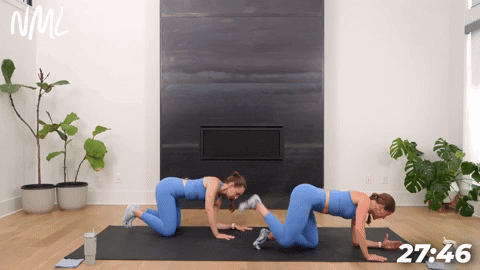
How to Do a 4-Point Donkey Kick
- Start in a tabletop position with your knees bent at 90-degree angles and your hips stacked over your knees. Place your left forearm and right hand flat on the mat, shoulders stacked over elbows.
- Maintain the 90-degree bend in your right knee as you lift your right leg off the ground, pressing your right heel towards the ceiling. Left knee remains planted on the ground. Focus on moving your leg by squeezing your glutes rather than arching through the back.
- With control, slowly lower your right knee, returning to the starting position.
3. 3-Pulse Long Lunge and Hinge
Targets: Quadriceps, glutes, hamstrings, hip flexors, core (stabilizers) and shoulders.
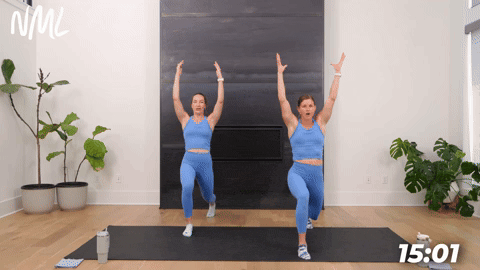
How to Do a 3-Pulse Long Lunge and Hinge
- Start standing tall with your feet hip-width apart, arms relaxed at your sides.
- Step your right foot back into a reverse lunge, bending both knees to 90 degrees. Keep your chest lifted and your arms reaching overhead.
- Pulse gently 3 times at the bottom of the lunge, lowering and lifting just a few inches with control (count: 1, 2, 3).
- After the final pulse, hinge forward at the hips, maintaining a long spine, and swing your arms down and around so your fingertips point toward the wall behind you.
- Reverse the motion: sweep your arms back overhead, lift your chest and return to the low lunge position.
Modification: If lunges hurt your knees, check out these exercise modifications.
4. Single-Leg Glute Bridge Hold and Power Lift Off
Targets: Gluteus maximus, gluteus medius, calves, hips, hamstrings and abs.
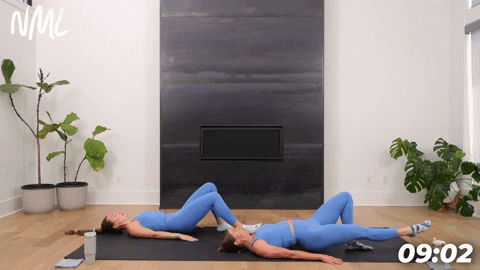
How to Do a Single-Leg Glute Bridge Hold and Power Lift Off
- Start lying on your back, feet hip-width apart and knees bent.
- Press through your heels to lift your glutes off the mat, squeezing your glutes as you lift. Think about keeping your core engaged and knees in line with your hips. Keep your right foot planted on the floor, and then extend your left toes straight overhead.
- Inhale as you lower your right toes towards the ground, hovering them off the mat. Think about keeping your hips high and stable, pressing through your right foot for stability.
- Exhale as you reverse the motion, lifting your left toes to stack over your left foot, returning to the starting position.
Modification: Find a staggered stance glute bridge by keeping your left heel on the ground. Rather than straightening the left leg, keep it bent at 90 degrees as you lift it off the mat. Keeping the leg bent reduces the intensity of the exercise.
5. Pilates Teaser
Targets: Deep core muscles (transverse abdominis), rectus abdominis, obliques, hip flexors (iliopsoas), spinal stabilizers (erector spinae) and quadriceps.
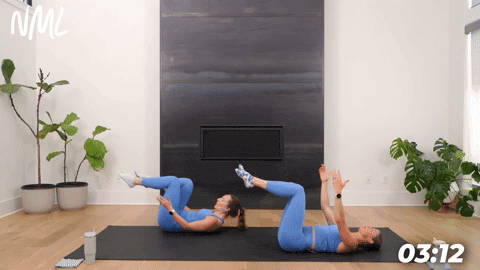
How to Do a Pilates Teaser
- Start lying flat on your back with your legs extended long on the mat and arms reaching overhead. Keep your lower back gently pressing into the mat.
- Inhale to prepare. As you exhale, begin to roll up through your spine, lifting your head, shoulders and arms off the mat.
- At the same time, lift your legs off the mat, keeping them together and straight (or slightly bent if needed).
- Balance on your sit bones, forming a “V” shape with your body. Your arms should be extended forward, parallel to your legs, and your spine tall.
- Hold for a breath, engaging your core to maintain balance.
- Slowly lower down with control, rolling through the spine until your back and legs return to the mat.
Modification: Keep your shoulders on the mat. Reduce the intensity of the exercise by performing alternating single-leg kickouts.
6. Pilates Hundreds
Targets: Deep core muscles (transverse abdominis), lower abdominal muscles and rectus abdominis muscles.

How to Do Pilates Hundreds
- Start sitting on the floor with your legs bent at 90 degrees. Lean back slightly, sitting on your sit bones (two sitting bones and tailbone), keeping a nice, long spine, shoulders down and back.
- Place your hands behind your knees and lift your feet off the ground. Bent legs are extended out in front of you.
- If possible, slowly straighten your legs out in front of you. Raise the tips of your toes to eye-level or just higher.
- Then straighten your arms, extending them out at shoulder height, palms facing down. Pulse your arms up and down 2-3 inches, while holding this position (pilates hundreds or boat pose).
Modification: Keep your shoulders on the mat. Reduce the intensity of the exercise by keeping the legs bent, knees tucked in towards your chest.
7. Side Lying Leg Slide and Kick
Targets: Internal and external oblique muscles (the muscles that run along the side of your core) and transverse abdominus.
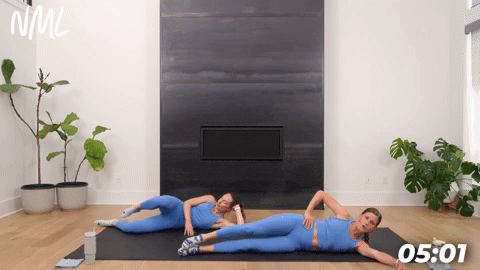
How to Do a Side Lying Leg Slide and Kick
- Start lying on your side, right arm on the mat, left hand behind your head. Extend both legs long, feet stacked on top of one another. Brace your core. Lift your head and neck off the ground.
- Pull the top (left) knee in towards your face. Then, extend the left leg long, left toes pointing towards the ceiling.
- With control, keep the left leg straight as you slowly lower it back to meet the right leg. Left foot to meet right foot.
Modification: Reduce the intensity of the exercise by keeping the leg that’s resting on the mat slightly bent.
FAQs
Yes, a well-designed Pilates class can build strength, burn calories and improve endurance in just 20 minutes. Pilates moves aren’t just a great core workout – they also target the upper-body and lower-body. The key is to incorporate these movements consistently and focus on proper form during each exercise.
Barre, Pilates and lifting heavy weights can all contribute to a lean physique. Barre focuses on precise movements and isometric holds while incorporating stretching to enhance flexibility and posture. Pilates is similar, focusing on controlled movements, deep core strength and flexibility. Lifting heavy weights is the best way to build muscle mass. By strength training and reducing overall body fat, you’ll create a lean and sculpted physique. Ultimately, I’d recommend combining different types of exercise for the best results. You might follow a workout plan like the “3-2-8” Method that combines strength training with Pilates.
To see the best results, I recommend that beginners start with 2-3 Pilates sessions a week. This frequency allows your body enough time to recover between sessions. Following a consistent fitness routine will lead to increased strength and definition.
To incorporate weights into a mat Pilates workout, try hand weights, ankle weights or resistance bands. This type of equipment will add resistance to exercises, targeting specific muscle groups and enhancing core engagement.
More Workouts
Pilates WorkoutsPin This At-Home Pilates Workout (30 Minutes, 7 Exercises)
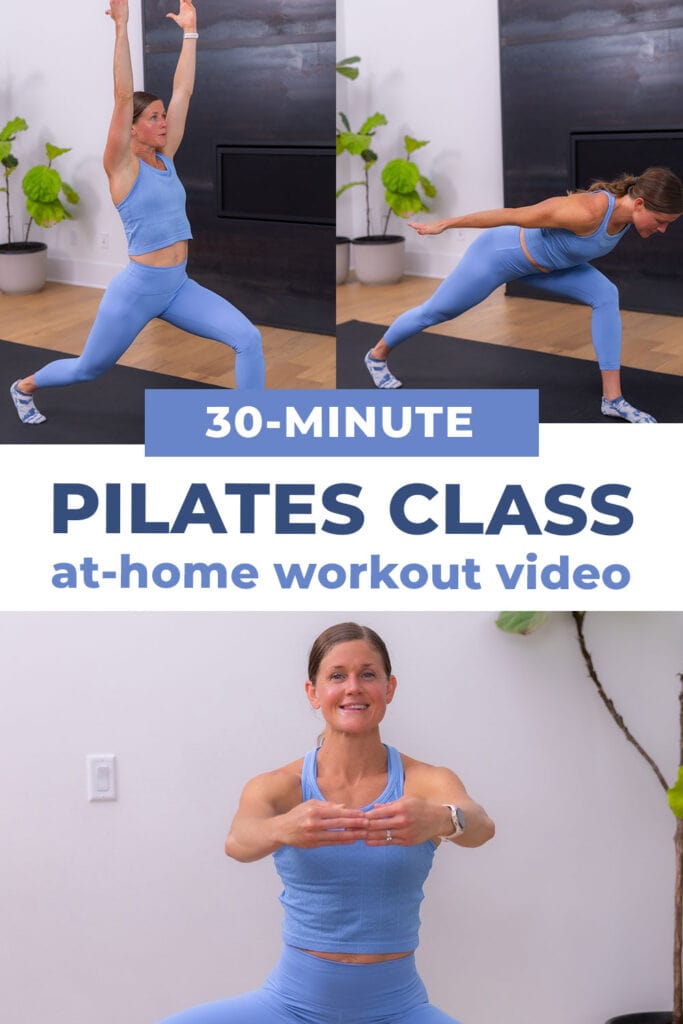











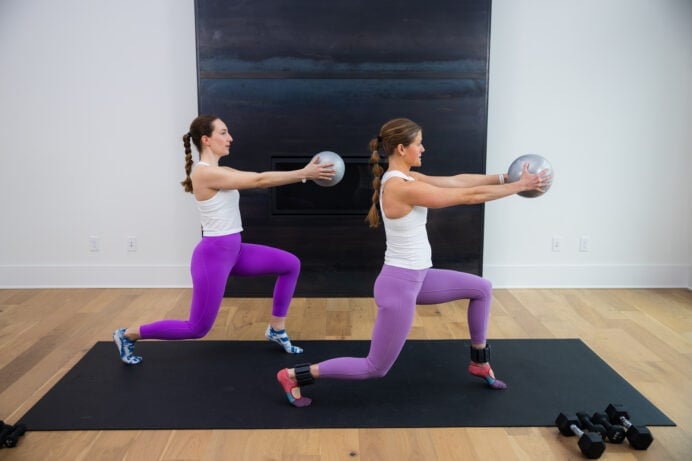
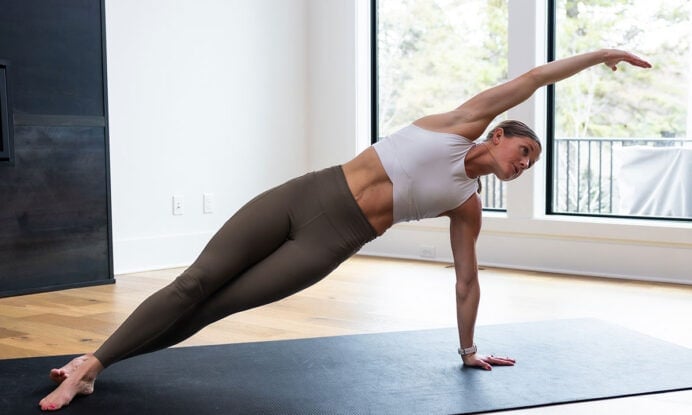
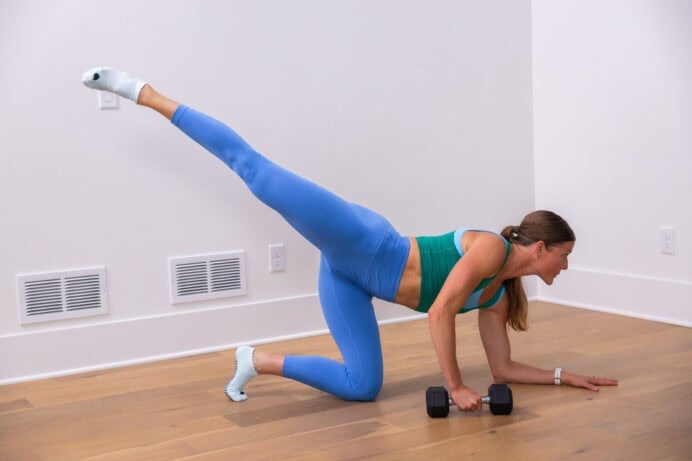
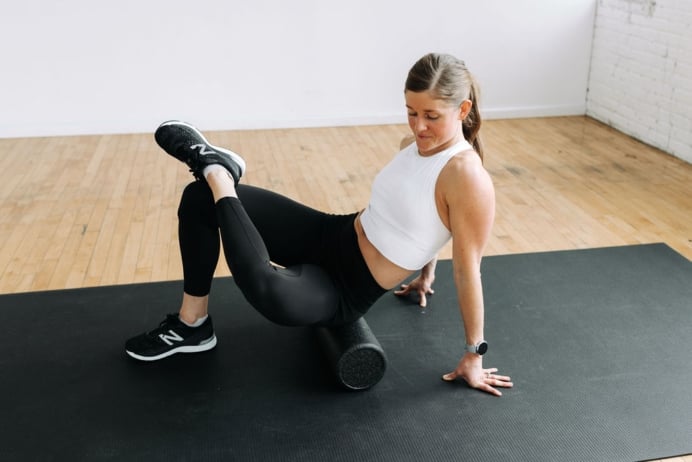
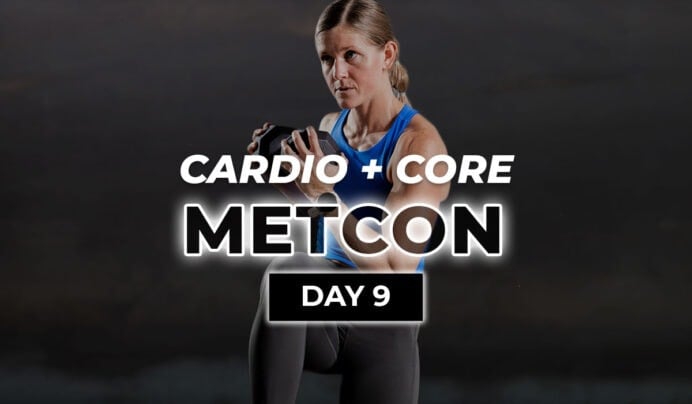

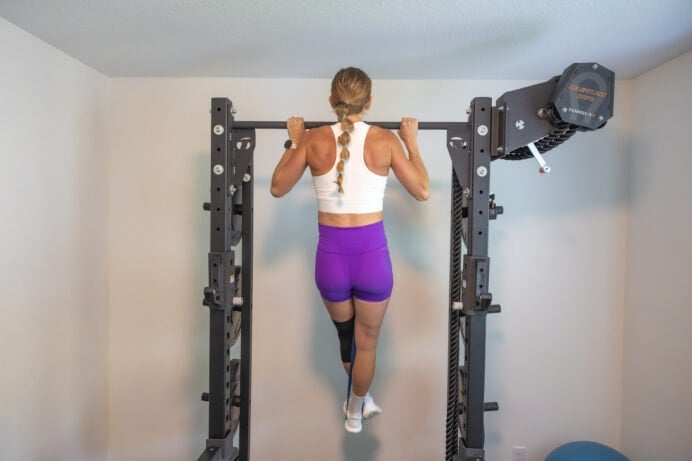

Great Workout
Thanks for trying this Pilates workout! I’m glad you enjoyed it! -Lindsey